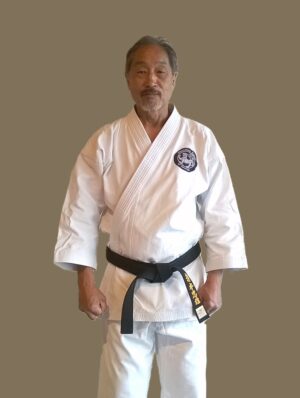 John Teramoto (Godan*) began training with Mr. Tsutomu Ohshima, founder (Chief Instructor) and founder of Shotokan Karate of America (SKA), in 1963 at the age of 13 while a student at Maryknoll Elementary School in his native Los Angeles, CA. Mr. Ohshima one day appeared at the school to become the new Japanese language teacher. At the time, John had no idea who Mr. Ohshima or what karate was. He simply decided he wanted to learn martial arts from the man. He gathered his 6th-, 7th-, and 8th-grade schoolmates, and they formed what might be the first elementary school karate group in the world (the group celebrated its 60th Anniversary in 2023). John received his Godan (5th degree black belt—the highest rank granted and recognized by SKA) from Ohshima Sensei in 1990. From 1998 to 2017 he served as President of SKA’s Black Belt Council (yūdanshakai) and from 2017 to 2018 he served as President of SKA. In 2020 Dr. Teramoto was named Shihan of SKA.
John Teramoto (Godan*) began training with Mr. Tsutomu Ohshima, founder (Chief Instructor) and founder of Shotokan Karate of America (SKA), in 1963 at the age of 13 while a student at Maryknoll Elementary School in his native Los Angeles, CA. Mr. Ohshima one day appeared at the school to become the new Japanese language teacher. At the time, John had no idea who Mr. Ohshima or what karate was. He simply decided he wanted to learn martial arts from the man. He gathered his 6th-, 7th-, and 8th-grade schoolmates, and they formed what might be the first elementary school karate group in the world (the group celebrated its 60th Anniversary in 2023). John received his Godan (5th degree black belt—the highest rank granted and recognized by SKA) from Ohshima Sensei in 1990. From 1998 to 2017 he served as President of SKA’s Black Belt Council (yūdanshakai) and from 2017 to 2018 he served as President of SKA. In 2020 Dr. Teramoto was named Shihan of SKA.
Dr. Teramoto did his undergraduate work at Loyola Marymount University in Los Angeles, and he received his M.A. and Ph.D. degrees from the University of Michigan in Ann Arbor, MI, in the field of Asian Art History. He has spent many years in Japan studying the language and as a visiting graduate student at the Tokyo University of Fine Arts. He has also lived in Japan as a Fulbright-Hays scholar, as a professor at the Japan Center for Michigan Universities in Hikone, Shiga Prefecture, and most recently as a visiting professor at the prestigious International Research Center for Japanese Culture in Kyoto. Now, as in the past, whenever he is in Tokyo he practices at Waseda University, Ohshima Sensei’s alma mater, with members of the Waseda University Karate Club.
In November 2023, Dr. Teramoto retired after serving over 23 years as Curator of Asian Art at the Indianapolis Museum of Art at Newfields.
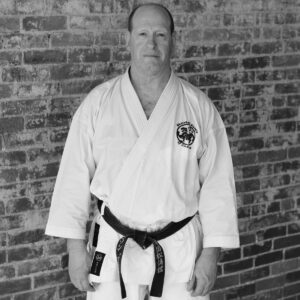 Brad Markisohn (Sandan) began his karate training with the SKA group at the University of Delaware in 1982. Without any real knowledge of martial arts, but with a strong interest in finding our more, he joined the University of Delaware Shotokan Karate Club and continued practicing until he graduated and moved to Indiana to attend graduate school at Indiana University. During that time he received his Shodan (1st degree Black Belt) from Ohshima Sensei in 1988. He has led karate groups at Indiana University in Bloomington and also in Indianapolis since the late 80’s. He has been training with John Teramoto since 2000, and he received his current rank of Sandan (3rd degree Black Belt) in 2006. Mr. Markisohn serves as the dojo leader for the Indianapolis Shotokan Karate Dojo. He travels to Southern California to practice at the Shotokan Ohshima dojo several times a year, and he also travels to practice with SKA members in other regions.
Brad Markisohn (Sandan) began his karate training with the SKA group at the University of Delaware in 1982. Without any real knowledge of martial arts, but with a strong interest in finding our more, he joined the University of Delaware Shotokan Karate Club and continued practicing until he graduated and moved to Indiana to attend graduate school at Indiana University. During that time he received his Shodan (1st degree Black Belt) from Ohshima Sensei in 1988. He has led karate groups at Indiana University in Bloomington and also in Indianapolis since the late 80’s. He has been training with John Teramoto since 2000, and he received his current rank of Sandan (3rd degree Black Belt) in 2006. Mr. Markisohn serves as the dojo leader for the Indianapolis Shotokan Karate Dojo. He travels to Southern California to practice at the Shotokan Ohshima dojo several times a year, and he also travels to practice with SKA members in other regions.
Mr. Markisohn did undergraduate work majoring in Geology and Physics at the University of Delaware, and he did graduate work at Indiana University in Bloomington, where he earned his M.S. degree in Geophysics. He held several technical and managerial positions in the medical diagnostics and consumer electronics industries. He currently manages the development of diabetes products in Roche Diagnostics Diabetes Care Division.
Vladimir Fokin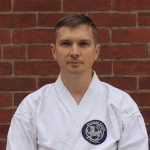 (Sandan) was born and raised in Russia. He completed his undergraduate studies in Mathematics at Novosibirsk State University, and earned his PhD in Mathematics from Purdue University after moving to the United States. He worked for a few years at IUPUI, teaching mathematics and conducting research in mathematical applications in cancer diagnostics. Later, he worked at Roche Diabetes Care in the development of glucose meters, and currently works at iRhythm in Cardio Monitoring. Vladimir began his martial arts training in Judo in 1986. After a couple of years, he started training in Shotokan Karate while still in Russia. He joined Shotokan Karate of America in 2006 after meeting John Teramoto and Brad Markisohn.
(Sandan) was born and raised in Russia. He completed his undergraduate studies in Mathematics at Novosibirsk State University, and earned his PhD in Mathematics from Purdue University after moving to the United States. He worked for a few years at IUPUI, teaching mathematics and conducting research in mathematical applications in cancer diagnostics. Later, he worked at Roche Diabetes Care in the development of glucose meters, and currently works at iRhythm in Cardio Monitoring. Vladimir began his martial arts training in Judo in 1986. After a couple of years, he started training in Shotokan Karate while still in Russia. He joined Shotokan Karate of America in 2006 after meeting John Teramoto and Brad Markisohn.
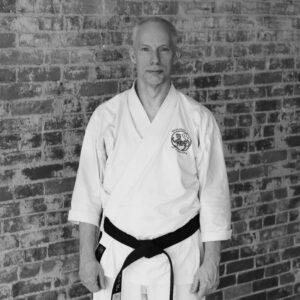 Todd Chilton (Nidan) was born in 1963 in New York City, and has lived in Indiana since 1992. His martial arts training originally began with Tae Kwon Do and Gojū-ryū karate in high school and college. He took a break from training in the 1990’s while finishing school and working full time. By 2005 he felt something was missing, that he needed something more from his life. As he puzzled over this, he discovered he missed practicing martial arts. He looked at several dojos but decided to join the Indianapolis Shotokan group. When asked why, he said, “I called the dojo and was invited to watch a practice. I noticed the students had a great attitude, they actually cleaned the floor before the class to make sure it was ready for them to practice. During the class, the instructors emphasized making strong techniques that really worked. They practiced fighting drills not just for tournaments, but for facing an opponent strongly, both mentally and physically. I could see the instructors enjoyed teaching, and wanted the students to get a high quality experience from the class. I liked the way the instructors challenged the students to face problems with a strong karate attitude – this was what was missing in my life. I knew I was in the right place.” Todd earned his Shodan (1st degree Black Belt) in 2010 and Nidan (2nd degree Black Belt) in 2023. He is a psychologist who works with veterans.
Todd Chilton (Nidan) was born in 1963 in New York City, and has lived in Indiana since 1992. His martial arts training originally began with Tae Kwon Do and Gojū-ryū karate in high school and college. He took a break from training in the 1990’s while finishing school and working full time. By 2005 he felt something was missing, that he needed something more from his life. As he puzzled over this, he discovered he missed practicing martial arts. He looked at several dojos but decided to join the Indianapolis Shotokan group. When asked why, he said, “I called the dojo and was invited to watch a practice. I noticed the students had a great attitude, they actually cleaned the floor before the class to make sure it was ready for them to practice. During the class, the instructors emphasized making strong techniques that really worked. They practiced fighting drills not just for tournaments, but for facing an opponent strongly, both mentally and physically. I could see the instructors enjoyed teaching, and wanted the students to get a high quality experience from the class. I liked the way the instructors challenged the students to face problems with a strong karate attitude – this was what was missing in my life. I knew I was in the right place.” Todd earned his Shodan (1st degree Black Belt) in 2010 and Nidan (2nd degree Black Belt) in 2023. He is a psychologist who works with veterans.
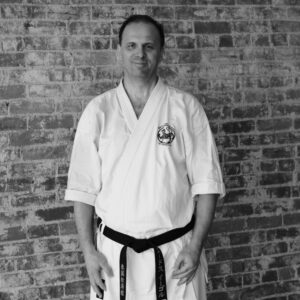
Igor Gejdos (Shodan) is originally from Slovakia and only began his karate training after coming to the United States. He started training with the SKA Butler University Karate Club in 2007 per suggestion from Brad Markisohn. He received his Shodan (1st degree Black Belt) in 2014. “What I respect about the Shotokan Karate of America practice is the emphasis on Japanese culture and tradition, the depth and attention to detail and the self improvement. It has so much to offer to improve our daily lives.” Igor had an opportunity to travel and practice with other SKA groups in the US, and with our affiliate groups overseas in France and Switzerland. He has a MS degree in Computer Science from Purdue University, and he currently works on developing medical devices.
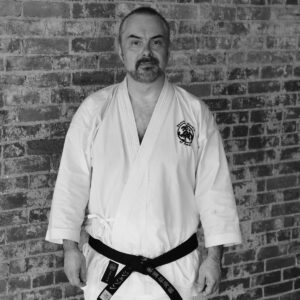 Jason Wright (Shodan) was born in Anderson, Indiana. He originally began training in 2003 when the group was part of Butler University. He was introduced to practice by an old high school friend who was training. He took up his friend’s invitation to come watch. “When I came to watch practice for the first time, I was very impressed by the strong spirit given by all and knew this was something I wanted to try”. Practice has helped Jason with his physical health, career, as well as improving his mindset and perspective on life. “Thanks to my seniors, I have an appreciation for an art that is very deep and challenging. Something that I just happened to stumble into by chance”. Jason is an audio/visual technician working for a commercial integrator with over 20 years of experience in his field. Outside of tuning and commissioning project installations, he enjoys working as a sound operator for various events as well as playing and writing music.
Jason Wright (Shodan) was born in Anderson, Indiana. He originally began training in 2003 when the group was part of Butler University. He was introduced to practice by an old high school friend who was training. He took up his friend’s invitation to come watch. “When I came to watch practice for the first time, I was very impressed by the strong spirit given by all and knew this was something I wanted to try”. Practice has helped Jason with his physical health, career, as well as improving his mindset and perspective on life. “Thanks to my seniors, I have an appreciation for an art that is very deep and challenging. Something that I just happened to stumble into by chance”. Jason is an audio/visual technician working for a commercial integrator with over 20 years of experience in his field. Outside of tuning and commissioning project installations, he enjoys working as a sound operator for various events as well as playing and writing music.
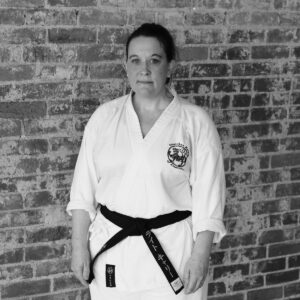 Kari Ann Wright (Shodan)
Kari Ann Wright (Shodan)
* There are three colors of belts in SKA: black belt, brown belt, and white belt. The black belts (called “dan”) are further classified into 5 ranks: Godan (5th degree black belt, the highest in SKA, also the highest rank awarded by Master Funakoshi), Yodan (4th degree), Sandan (3rd degree), Nidan (2nd degree), and Shodan (1st degree). Below black belt level, there are 8 ranks called “kyu”: brown belt is from 1st Kyu (the highest) to 3rd Kyu, white belt is from 4th Kyu to 8th Kyu.
